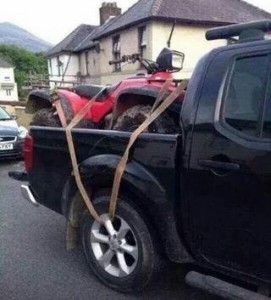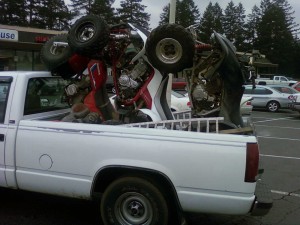The rules on how to tie down your ATV on a trailer requires you have to have four tie down points.
ATV’s must be tied down using a four point system regardless if on an open trailer, enclosed trailer or on back of a pickup. To Secure your ATV with four tie down points use two in the front and two in the back to prevent forward, backward, and side-to-side movement.
“Can I run a strap through the frame to two points?”
Using one tie down on two points is OK, however if you are towing in the states this is counted as one point.
“Can I use my Winch as one of the four points?”
No, each of the four points must be at a corner of the ATV.”Use my Winch as an additional fifth point?”
The reason you shouldn’t use your winch to tie down your ATV is the metal planetary gears will wear out the plastic teeth inside the housing when the ATV bounces around. Another point is that winch cables do not have any give. After a while, your cable is going to be prone to breaking. It is also illegal in Canada to use the winch as a tie down.
“Which Tie Down”
There are three main types of tie downs. These are the cam straps, over-center lever cam style straps and ratchet straps. We recommend only using the ratchet straps to tie down your ATV.
“What are Ratchet Straps?”
Ratchet straps use a ratcheting slotted drum and a ratchet crank handle to tension the strap. Once the webbing is threaded through the slotted drum, the ratchet crank handle is used to take up the slack and tension the strap to the desired level. The ratchet lever is then rotated to the closed position. It is important that there is at least one complete wrap of the webbing around the drum since this type of mechanism relies on the friction between the wrapped layers of webbing to keep the webbing from slipping through the slot when under tension. Too many wraps of webbing around the drum may cause the mechanism to jam and although the ratchet is tight the straps to the ATV could be loose.
Releasing the tension is a simple matter of pulling the center latch and rotating the ratchet crank handle to the open position and pulling the webbing back through the slotted drum. Ratchet straps come in one inch up to four inch strap sizes.
For extra security you can choose tie-down straps that have spring retainer hooks. The retainers prevent the hooks from either detaching from the ATV and trailer. This prevents the tie down strap from coming loose when hitting a bump in the road. If you already have tie-down straps without spring retainers, you could cut the S-hooks off and replace them with self-locking hooks such as a carabiner
“Tie Down Quality ?”
You paid good money for your ATV. Think about the quality of the ratchet straps you are using to tie down your ATV. A pair of cheap straps that breaks or snaps could mean the loss of your ATV and more importantly possible a disastrous accident which you would be found liable for.
For best results, be sure to choose a ratchet strap with an adequate working load limit (WLL) to secure the weight of your vehicle. Note that the WLL is the breaking limit of the strap not the carrying load!
“Location”
Check your ATV manual, some ATVs and UTVs have tie down slots for the hooks on your straps. Do not wrap the strap around the axles or any other moving part that is vulnerable to bending or breaking. We recommend using the frame of the ATV to fasten your ratchet straps.
“Can I tie down using the Racks?”
Most front racks on ATV’s are rated to support 100-120 lbs. and most rear racks are rated to support 200-240 lbs. If you are attaching your tie-downs to your racks you can easily exceed their rated capacity causing them to bend or worst snap and losing your ATV on the road.
“How to Tie Down”
For maximum safety, you should use four separate straps, one for each side of the ATV.
For each strap, hook one end onto the ATV’s frame and other end to closest tie down point on the trailer.
Now you will need to pass the excess piece of strap through the ratchet and simply pull tight and then ratchet to tighten the strap in such a way that the ATV compresses it’s tires. Once all the straps are secured and tightened, take the excess strap and tie it into a knot below the ratchet to prevent it from blowing around, dangling below the trailer and possibly getting caught on something.
To test the tie-down job, push the ATV in each direction slightly. There should be no excess sliding of the ATV and the trailer should move just as the ATV moves because they’re securely fastened to one another.
Start down the road and after a couple kilometers pull over and check if the straps need to re-tighten.
“Do you need Wheel Chocks”
It’s not necessary if the ATV is tied down correctly, however using wheel chocks is better than not. Wheel chocks work best if they are attached to the trailer deck or pickup bed.
“Which Gear”
If you search the internet for this question you will find quite a few different answers:
- You will find individuals stating that to tie down an ATV it must be first in neutral and after the straps are tightened that you place the ATV in park.
- Others will state that you park your ATV on the trailer/pickup and tie it down and leave it in park.
- Quite a few answers say never transport your ATV in “park”. The ATV has to be in neutral because when the ATV rocks back and forth when you are stopping or taking off you will wear out the transmission.
- and this answer: if you do transport in “park” you have to strap the brake levers on.
It is our opinion that today’s modern ATV’s can be transported in “park”. That is one of the reasons it was designed for. When your ATV is in park the transmission is disengaged.
“How Much Tension”
So you successfully tied down your ATV onto it’s frame and onto the trailer and tightened the ratchets until your tires compressed. Now if you hit a bump your suspension compresses and you can have a tie down come off losing your ATV or you cranked the tie downs so much the suspension cannot compress anymore and you’ve blown your shocks out.
Well not really. By fastening your tie downs to the frame you are not compressing your shocks. You are compressing your tires but the shocks are fine and will not suddenly blow out and even if you did compress your shocks it will not hurt the shocks to keep them compressed for any length of time.
“Tie Down Maintenance”
A simple check can pay big dividends or at least save the cost of a new ATV.
- Replace your straps when the webbing shows sign of wear or when the hooks have become misshaped.
- Maintain the ratchet mechanism with periodic lubrication of the moving parts.
- Periodically check your trailer hooks to ensure that they are securely fastened to the trailer.


